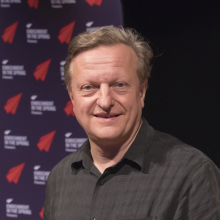We are pleased to announce that Gabriel Wittum, professor of Applied Mathematics and Computational Science, Kaust (Saudi Arabia), will give the SFB 1313 "Pretty Porous Science Lecture" #54. His talk will be on "Simulation of density-driven flow in heterogenous and fractured porous media".
Date: 25 April 2024
Time: 4:30- 5:30 pm CET
Speaker: Professor Gabriel Wittum, Department of Applied Mathematics and Computational Science, Kaust (Saudi Arabia)
Lecture title: "Simulation of density-driven flow in heterogenous and fractured porous media"
Place: Multi Media Lab (MML), U1.003, Pfaffenwaldring 61, 70569 Stuttgart, Campus Vaihingen. If you are interested in participating in the lecture, please contact edward.coltman@iws.uni-stuttgart.de
Hybrid Access: https://unistuttgart.webex.com/unistuttgart-en/j.php?MTID=m135c01f6c657e35403b1cf99728887a4
Abstract
The study of fractured porous media is an important and challenging problem in hydrogeology. One of the difficulties is that mathematical models have to account for heterogeneity introduced by fractures in hydrogeological media. Heterogeneity may strongly influence the physical processes taking place in these media. Moreover, the thickness of the fractures, which is usually negligible in comparison with the size of the whole domain, and the complicated geometry of fracture networks reduce essentially the efficiency of numerical methods. In order to overcome these difficulties, fractures are sometimes considered as objects of reduced dimensionality(surfaces in three dimensions), and the field equations are averaged along the fracture width.
Fractures are assumed to be thin regions of space filled with a porous material whose properties differ from those of the porous medium enclosing them. The interfaces separating the fractures from the embedding medium are assumed to be ideal. We consider two approaches:
(i) the fractures have the same dimension, d, as the embedding medium i.e. they are d-dimensional;
(ii) the fractures are considered as (d-1)-dimensional manifolds, and the equations of density-driven flow are found by averaging the d-dimensional laws over the fracture width.
We show that the second approach is a valid alternative to the first one. For this purpose, we perform numerical experiments using a finite-volume discretization for both approaches. The results obtained by the two methods are in good agreement with each other.
We derive a criterion for the validity of the simplified representation. The criterion characterises the transition of a mainly parallel flow to a rotational flow, which can not be reasonably approximated using a d-1 dimensional representation. We further present a numerical algorithm using adaptive dimensional representation.
About Gabriel Wittum
Professor Wittum’s research focuses on a general approach to modelling and simulation of problems from empirical sciences, in particular using high performance computing (HPC). Particular areas of focus include: the development of advanced numerical methods for modelling and simulation, such as fast solvers like parallel adaptive multi-grid methods, allowing for application to complex realistic models; the development of corresponding simulation frameworks and tools; and the efficient use of top-level supercomputers for that purpose. These methods and tools are applied towards problem-solving in fields including computational fluid dynamics, environmental research, energy research, finance, neuroscience, pharmaceutical technology and beyond.


